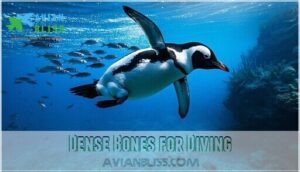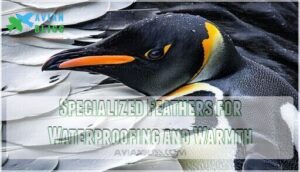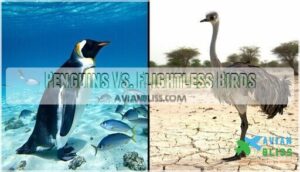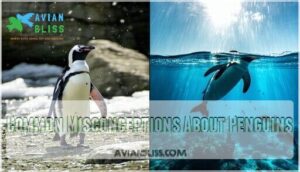This site is supported by our readers. We may earn a commission, at no cost to you, if you purchase through links.
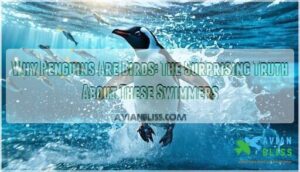
Despite their fish-like swimming abilities and inability to fly, penguins possess all the essential bird characteristics: feathers, beaks, wings, and they lay eggs.
Their wings have simply evolved into powerful flippers that let them "fly" underwater at incredible speeds, think of them as birds that traded the sky for the sea.
Their dense bones help them dive deep, while their waterproof feathers keep them warm in icy waters.
These tuxedo-wearing swimmers represent millions of years of evolutionary genius, proving that being a bird doesn’t always mean soaring through clouds—sometimes it means ruling the waves with remarkable underwater acrobatics, and showcasing incredible speeds in their natural habitat, as a result of their unique adaptation to the aquatic environment, making them a prime example of evolutionary genius.
Table Of Contents
- Key Takeaways
- Why Penguins Are Birds?
- Penguin Taxonomic Classification
- Penguins’ Physiological Features
- Penguins Vs. Flightless Birds
- The Nature of Penguins
- Why Penguins Are Classified as Birds
- Penguin’s Life on Land
- Conservation Concerns for Penguins
- Expert Opinions on Penguin Classification
- Common Misconceptions About Penguins
- Frequently Asked Questions (FAQs)
- Why is a penguin a bird and not fly?
- Why is a penguin not a mammal?
- Are penguins more bird or fish?
- Are penguins descended from birds?
- Why is a penguin a bird and not a fish?
- Do penguins classify as birds?
- Why is a penguin a bird if it can’t fly?
- Why aren’t penguins mammals?
- What are the key physical traits of penguins?
- How do penguins move on land?
- Conclusion
Key Takeaways
- You’ll discover that penguins possess all essential bird characteristics—feathers, beaks, wings (evolved into flippers), and egg-laying abilities—despite their inability to fly through air.
- You can observe how penguins’ wings transformed into powerful flippers over 60 million years ago, allowing them to "fly" underwater at speeds up to 22 mph instead of soaring through skies.
- You’ll find that penguins’ specialized adaptations like dense bones for diving, waterproof feathers, and streamlined bodies prove birds don’t need flight to thrive in different environments.
- You can see how penguins belong to the Spheniscidae family within class Aves, sharing the same evolutionary ancestry and fundamental biological systems as all other birds.
Why Penguins Are Birds?
Despite their unique appearance, penguins are definitely birds belonging to the class Aves.
These remarkable creatures share fundamental avian characteristics like feathers, beaks, and hollow bones with their flying relatives.
What makes penguin classification fascinating is their bird evolution story—they descended from flying ancestors but developed flightlessness causes around 60 million years ago.
Penguins transformed from sky masters to ocean champions, proving evolution’s incredible power to reimagine what it means to be a bird.
Their aquatic traits include specialized feather structure with dense, waterproof plumage and powerful flippers instead of wings.
These diving abilities allow them to plunge 500 meters deep, showcasing how bird anatomy adapted perfectly for marine life while maintaining core bird species characteristics.
The study of birds that look like penguins penguin lookalikes reveals interesting comparisons with true penguins regarding their physical characteristics and behaviors.
Penguin Taxonomic Classification
You’ll discover that penguins belong to the Spheniscidae family within the class Aves, placing them firmly in the bird category alongside eagles, sparrows, and other feathered creatures.
This scientific classification confirms what biologists have known for decades – despite their inability to fly, penguins share the same fundamental characteristics that define all birds.
Spheniscidae Family
When studying bird classification, you’ll discover that penguins belong to the remarkable Spheniscidae family. This exclusive group contains all 18 penguin species, from tiny Little Blue penguins to massive Emperor penguins.
Penguin evolution within Spheniscidae began over 60 million years ago, creating incredible species diversity through unique adaptations.
Here’s what makes Spheniscidae special:
- Flightless birds with flipper-like wings designed for underwater propulsion
- Dense bone structure enabling controlled diving up to 500 meters deep
- Waterproof plumage featuring tightly packed feathers for thermal regulation
- Specialized beaks shaped for catching fish, squid, and krill
Family dynamics within Spheniscidae showcase fascinating aquatic traits. These avian characteristics distinguish them from other bird families while maintaining core bird anatomy features. Their penguin classification demonstrates how flightless birds can thrive in marine environments through specialized evolutionary paths.
The development of baby penguin characteristics is essential for their survival and growth in these environments.
Class: Aves
You’re looking at one of nature’s most fascinating examples of bird classification. Penguins belong to Aves, sharing fundamental avian characteristics with all birds despite their aquatic lifestyle.
They possess feathers, are warmblooded, and have a fourchambered heart – essential traits that define birds. Their skeletal system and beak structure reflect millions of years of feather evolution and marine adaptation.
While they can’t fly, penguins retain the core biological blueprint that makes them true birds.
| Bird Trait | Penguin Example |
|---|---|
| Feathers | Dense, waterproof plumage |
| Warm-blooded | Body temperature regulation |
| Four-chambered heart | Efficient oxygen circulation |
This classification isn’t just academic – it reveals how evolution shapes life for different environments while maintaining fundamental characteristics.
Penguins’ Physiological Features
When you examine a penguin’s body, you’ll discover remarkable adaptations that prove these aquatic masters are indeed birds.
Their dense bones help them withstand crushing water pressure during prolonged plunges, while their specialized multi-layered feathers create an efficient waterproof barrier that keeps them warm in frigid Antarctic waters, showcasing their unique ability to thrive in such environments with specialized features.
Dense Bones for Diving
You’ll find that penguins possess remarkably heavy bones unlike typical birds, making them polar animals perfectly suited for underwater life.
This bone density adaptation allows these incredible diving champions to descend up to 500 meters deep while maintaining buoyancy control in frigid waters.
Their aquatic skeleton works like a natural weight belt, helping them slice through ocean currents with their streamlined body shape.
These diving adaptations represent millions of years of evolution:
- Heavy bones counteract the buoyant effects of trapped air in dense feathers
- Reinforced skeletal structure withstands crushing water pressure at depth
- Bone density variations help different species target specific hunting depths
- Calcium-rich bones store minerals needed for egg production during breeding
- Aquatic skeleton modifications reduce energy costs while swimming underwater
This unique bird adaptations strategy proves that sometimes being "different" from your feathered cousins pays off in the survival game.
Penguins’ ability to move efficiently is also due to their knee joint structure that aids in propulsion and thermoregulation.
Specialized Feathers for Waterproofing and Warmth
Penguins possess waterproof feathers that function like nature’s most advanced wetsuit.
Their unique feather structure includes four distinct types: contour feathers create the outer waterproof coats, while plumules and afterfeathers form critical insulation layers beneath.
These dense feathers trap warm air against the skin, enabling thermal regulation in freezing Antarctic waters.
Feather maintenance proves essential for survival.
Penguins spend considerable time preening, using specialized oils to maintain waterproofing.
Filoplumes act as sensory structures, signaling when feathers need realignment.
The overlapping contour feathers create a seamless barrier, preventing heat loss while swimming.
This remarkable bird adaptation showcases evolutionary brilliance.
Counter-shading from their black-and-white plumage provides underwater camouflage, making penguins nearly invisible to both predators above and prey below, demonstrating how these specialized features guarantee survival.
Penguins Vs. Flightless Birds
You’ll find that penguins share a remarkable evolutionary journey with other flightless birds, yet their path to losing flight was uniquely driven by marine specialization rather than terrestrial adaptations.
While birds like ostriches and emus evolved flightlessness for land-based survival, penguins traded their aerial abilities for underwater mastery around 60 million years ago, which was driven by their need for marine specialization.
Evolutionary History
Sixty-two million years ago, penguin ancestors soared through Southern Hemisphere skies before trading wings for flippers.
The divergence timeline reveals their ancestral origins among flying seabirds, with fossil record evidence showing rapid transformation after the Cretaceous extinction event.
Climate influence during the Paleocene epoch drove speciation events as these avian descendants of dinosaur evolution adapted to cooling oceans.
| Time Period | Key Development | Environmental Driver |
|---|---|---|
| 62 MYA | First flightless penguins | Post-extinction cooling |
| 55 MYA | Rapid diversification | Ocean temperature shifts |
| 40 MYA | Modern body plan | Antarctic ice formation |
| Present | 18 extant species | Current climate zones |
This evolutionary biology journey proves penguins remain true birds despite their aquatic lifestyle.
Adaptation to Marine Life
Something remarkable happens when you examine how penguins adapted to marine life.
These Antarctic wildlife champions transformed their bodies into underwater marvels through specialized diving physiology.
Their streamlined bodies cut through water like living torpedoes, while dense bones provide ballast for prolonged plunges.
| Adaptation | Marine Function |
|---|---|
| Feather insulation | Traps air for warmth and buoyancy |
| Underwater vision | Clear sight for hunting prey |
| Saltwater adaptation | Filters salt through specialized glands |
Unlike other flightless birds, these aquatic seabirds converted wings into powerful flippers.
Their penguin facts reveal incredible efficiency: gentoo penguins reach 22 mph underwater, outpacing most fish in their watery domain.
The Nature of Penguins
When you observe penguins in their natural habitat, you’ll notice they’re perfectly designed for life both in water and on land.
These remarkable birds spend most of their time swimming and hunting in the ocean, but they return to shore for breeding, molting, and raising their young, which showcases their unique adaptation to both aquatic and terrestrial environments, highlighting their ability to thrive in different settings.
Aquatic Adaptations
When you watch penguins glide effortlessly through water, you’re witnessing millions of years of aquatic evolution.
Their Diving Physiology that enables descents to 1,800 feet is a remarkable adaptation.
Their Streamlined Body design reduces drag while dense bones provide natural ballast for prolonged plunges.
Feather Insulation creates multiple air layers, maintaining warmth in frigid waters while enabling precise Buoyancy Control.
The distinctive black-and-white plumage serves as Underwater Camouflage, making penguins nearly invisible to prey below and predators above.
Unlike other aquatic birds, penguins’ flipper-wings generate thrust through underwater "flying," reaching swimming speeds of 15 mph during hunting pursuits.
Terrestrial Behavior
On land, these remarkable birds showcase bird behaviors that demonstrate their true avian nature.
Their waddling gait results from legs positioned far back on their bodies—an adaptation that makes them powerful swimmers but creates that characteristic shuffle you’ve probably seen in documentaries.
Colony dynamics reveal complex social interactions typical of bird habitats.
Thousands of penguins gather in organized communities, with each pair maintaining their territory through specific bird characteristics like vocalizations and displays.
During the molting process, they huddle together for warmth and protection.
Predator evasion strategies include group vigilance and rapid movement when threatened.
Despite appearing clumsy, penguins can sprint surprisingly fast across ice and rocks.
Their bird behavior extends to sophisticated communication systems, with each penguin recognizing their mate’s unique call among thousands of others—a tribute to millions of years of bird evolution.
Why Penguins Are Classified as Birds
You might wonder how creatures that waddle on land and swim like torpedoes underwater can be classified as birds.
Despite their inability to fly, penguins share all the fundamental characteristics that define birds, including feathers, beaks, and the same basic skeletal structure as their airborne relatives, which makes them similar in many ways, and one key aspect is their feathers.
Anatomy and Physiology
Despite their aquatic lifestyle, penguins possess unmistakable avian anatomy that confirms their bird classification.
Their skeletal system features hollow bones typical of the avian family, though denser for diving physiology. Hidden beneath their plumage, you’ll find knee joints just like flying birds.
Their skeletal adaptations include a pronounced sternum keel where powerful swimming muscles attach. The bird physiology extends to their respiratory system, which stores oxygen for prolonged underwater excursions.
Even their foot structure follows standard avian patterns—webbed for swimming but fundamentally bird-like. These thermal regulation and structural features prove penguins are simply birds with specialized marine adaptations.
This is because penguins, like other birds, have specialized feather types that provide insulation and contribute to their streamlined shape.
Feathers and Beaks
Beyond their anatomy, you’ll find that penguins possess the quintessential feathers and beaks that define bird biology.
These aren’t just any feathers—they’re engineering marvels. Feather insulation works through four distinct feather types: contour feathers create waterproof barriers, afterfeathers add warmth, plumules trap air, and filoplumes sense environmental changes.
Plumage variations among species reflect different environmental needs. Their beaks showcase remarkable beak adaptations—specialized for gripping slippery fish while maintaining classic avian anatomy.
Beak function extends beyond feeding to include preening and desalination. Together, these features demonstrate bird physiology perfectly adapted for marine life.
- Dense, overlapping feathers creating an impenetrable water barrier
- Streamlined beaks slicing through water with surgical precision
- Air-filled plumage maintaining body heat in freezing conditions
- Specialized beak structures filtering salt from seawater
Penguin’s Life on Land
While you might picture penguins as purely aquatic creatures, they actually spend significant time on land during their breeding seasons.
These remarkable birds return to shore each year to mate, build nests, and raise their young using complex parental behaviors that reveal their true avian nature, showcasing their ability to adapt to different environments with remarkable ease.
Breeding Habits
Throughout their breeding season, penguins display remarkable monogamous mating behaviors that showcase their bird classification.
Courtship rituals involve synchronized dances, vocal displays, and gift-giving of carefully selected pebbles. Partners engage in mutual preening and head-bobbing ceremonies that strengthen their pair bonds.
Nesting behavior varies by species, with some constructing elaborate pebble nests while others use simple scrapes in the ground. Breeding cycles are tightly synchronized with seasonal food availability, ensuring ideal conditions for raising chicks.
For successful breeding, penguins often require specialized breeding kit tools.
| Breeding Aspect | Timing | Duration |
|---|---|---|
| Courtship | Early spring | 2-3 weeks |
| Nesting | Mid-spring | 1-2 weeks |
| Incubation | Late spring | 30-65 days |
| Colony formation | Annual | 4-6 months |
Breeding colonies can contain thousands of pairs, creating bustling communities where incubation methods involve both parents sharing egg-warming duties using specialized brood pouches.
Parental Care
Dedication defines penguin parenting, where both parents share incubation duties and chick rearing responsibilities.
You’ll witness remarkable parental bonds as these birds take turns warming eggs for 30-66 days. After hatching, parents continue their commitment through intensive fledgling care.
Their nesting habits showcase impressive coordination:
- Shared incubation – Parents alternate egg-warming shifts during harsh weather
- Regurgitated feeding – Adults provide pre-digested fish directly to hungry chicks
- Crèche formation – Young birds huddle together while parents forage at sea
- Extended protection – Fledgling care continues until chicks develop waterproof feathers.
These breeding rituals demonstrate why bird conservation efforts focus heavily on protecting penguin colonies. Parenting success directly impacts species survival, making undisturbed nesting sites essential for population stability.
Conservation Concerns for Penguins
While you might think penguins’ unique adaptations make them conservation success stories, these remarkable birds face serious threats that could reshape their populations within decades.
Climate change and habitat destruction now challenge the very ecosystems that allowed penguins to thrive for millions of years, posing a significant threat to their survival due to climate change.
Threats to Their Habitats
While penguins have adapted brilliantly to marine life, their terrestrial breeding grounds face severe threats from human activities.
Habitat Loss occurs when coastal development reduces nesting areas by up to 20% in affected populations. Fisheries infrastructure construction disrupts colonies, causing 15% annual population declines locally.
Ocean Pollution devastates these birds – oil spills affect 40% of African penguin colonies, while microplastics contaminate nearly half of tested penguins near cities. Heavy metals accumulate in 70% of urban-impacted colonies.
Tourism increases nest abandonment rates by 16%, and invasive species like rats reduce chick survival by 50%.
Ecosystem Disruption from overfishing depletes prey species, forcing adult penguins to lose body mass and increasing chick mortality by 33%.
These combined pressures threaten marine habitat integrity essential for bird conservation efforts. Understanding penguin habitat needs is vital for developing effective conservation strategies.
Impact of Climate Change
Accelerating sea level rise and ice melting are fundamentally transforming Antarctic habitats where penguins breed and feed.
Ocean warming has reduced krill density by 40% near key foraging grounds, forcing these marine life species to swim farther for meals.
Habitat loss affects 43% of breeding sites, with flooding risks increasing dramatically.
Emperor penguin colonies have declined 50% in some regions as stable ice platforms disappear.
Ecosystem shifts disrupt traditional food webs, while earlier snowmelt affects breeding cycles in one-third of monitored colonies.
These climate change threats demand urgent bird conservation efforts to protect penguin populations from potential extinction.
Expert Opinions on Penguin Classification
You’ll find that scientists consistently agree penguins belong to the bird family despite their swimming prowess.
Leading ornithologists point to their feathers, bone structure, and evolutionary history as definitive proof they’re true birds, not aquatic mammals, which is a key aspect of their evolutionary history.
Ongoing Taxonomic Debate
Complexity defines the ongoing penguin classification debate among scientists worldwide.
Despite clear evidence that penguins belong to class Aves, their taxonomic status sparks heated discussions in ornithology circles.
Researchers can’t agree whether penguins belong in Sphenisciformes or Pelecaniformes orders.
Phylogenetic analysis reveals their unique evolutionary history, making bird taxonomy challenging.
You’ll find experts debating penguin classification at every biological classification conference.
Their marine adaptations blur traditional bird definitions, forcing scientists to reconsider bird systematics entirely.
Here’s why this taxonomic status debate matters:
- Redefines our understanding of what makes a bird truly "bird-like"
- Challenges traditional classifications that seemed rock-solid for decades
- Impacts conservation funding and protection strategies worldwide
- Reveals nature’s incredible ability to bend evolutionary rules
Species debates continue as new fossil discoveries emerge, keeping penguin classification contentious.
Unique Adaptations
Beyond the ongoing scientific discussions, these Antarctic swimmers showcase nature’s most impressive engineering feats.
Their flipper evolution transformed wings into underwater propulsion systems, enabling speeds up to 36 km/h.
Feather insulation creates a waterproof barrier through tightly overlapping layers, while their streamlined bodies perfect aquatic locomotion.
Advanced diving techniques include specialized oxygen storage in blood and muscles.
Their unique beak structure grips slippery prey, and specialized feet provide ice traction.
Camouflage strategies using countershading help them hunt effectively, proving birds don’t need sky to soar with their streamlined bodies and specialized oxygen storage.
Observing such unique creatures often requires specialized bird watching gear to get a closer look, showcasing their ability to thrive in harsh environments with flipper evolution.
Common Misconceptions About Penguins
You’ve probably heard some penguin myths that make these incredible creatures seem less bird-like than they actually are. Let’s clear up the confusion surrounding bird classification and these remarkable marine birds.
Many people mistakenly think penguins are mammals because they’re such skilled swimmers. However, flightless birds like penguins belong firmly in the avian family tree.
Here are the most common misconception origins:
- Penguins are mammals due to their swimming abilities
- Their flippers are fins rather than modified wings
- All penguins live in freezing Antarctic conditions
- They can’t fly because they lost the ability recently
- Their aquatic adaptation makes them fundamentally different from other birds
Understanding proper bird classification reveals that penguins simply evolved different adaptations for flight – they "fly" underwater instead of through air, making them perfectly suited for marine life.
Frequently Asked Questions (FAQs)
Why is a penguin a bird and not fly?
Penguins can’t fly because they evolved flippers instead of wings for swimming. They’re still birds because they’ve feathers, lay eggs, and share the same evolutionary ancestry as other birds.
Why is a penguin not a mammal?
You’ll discover that 75% of their lives are spent underwater, yet penguins aren’t mammals because they lack mammary glands, don’t give live birth, and possess feathers instead of fur for insulation.
Are penguins more bird or fish?
You’ll find penguins are definitively birds, not fish. They’re classified in the class Aves, possessing feathers, beaks, and laying eggs—all essential bird characteristics despite their flightless, aquatic lifestyle adaptations.
Are penguins descended from birds?
Like branches on evolution’s tree, you’ll find penguins descended from flying birds that lived 60 million years ago.
These ancient ancestors gradually traded wings for flippers, adapting to aquatic life while keeping their fundamental bird identity, related to their ancestors.
Why is a penguin a bird and not a fish?
You’d classify penguins as birds because they’ve got feathers, lay eggs, and share DNA with other avian species.
Unlike fish, they’re warm-blooded, breathe air through lungs, and evolved from flying ancestors millions of years ago, which are key characteristics that distinguish them from other animals, making feathers a notable feature.
Do penguins classify as birds?
Yes, penguins definitely classify as birds. You’ll find they belong to the class Aves, sharing key bird traits like feathers, beaks, and egg-laying despite their flightless, aquatic lifestyle adaptations.
Why is a penguin a bird if it can’t fly?
Despite being flightless, you’ll find penguins share all defining bird characteristics: feathers, beaks, hollow bones, and egg-laying.
Flight isn’t required for bird classification—these aquatic masters evolved flippers from wings for underwater "flying.
Why aren’t penguins mammals?
Penguins aren’t mammals because they lay eggs, have feathers instead of fur, and lack mammary glands. You’ll find they’re birds with specialized adaptations for aquatic life.
What are the key physical traits of penguins?
You’ll notice penguins sport flippers instead of wings, dense waterproof feathers, webbed feet, and streamlined bodies. Their black-and-white coloration provides underwater camouflage while swimming.
How do penguins move on land?
You’ll notice penguins waddle awkwardly on land due to their short legs positioned far back on their bodies.
They use their flippers for balance and sometimes slide on their bellies across ice.
Conclusion
Remarkably, penguins can reach underwater speeds of 22 mph, faster than most Olympic swimmers.
Understanding why penguins are birds reveals nature’s incredible adaptability. You’ve discovered how these aquatic masters retain essential avian characteristics while conquering marine environments.
Their feathers, beaks, and egg-laying habits confirm their bird classification, despite their flightless nature.
These evolutionary marvels prove that birds don’t need wings for flight—sometimes the greatest success comes from specialized adaptation to unique environments, demonstrating unique environments.


